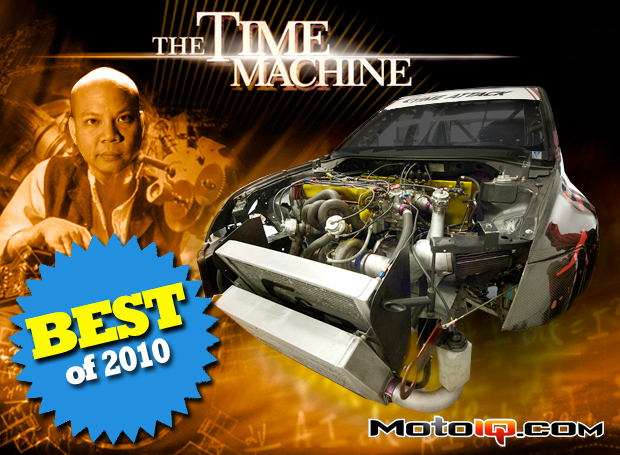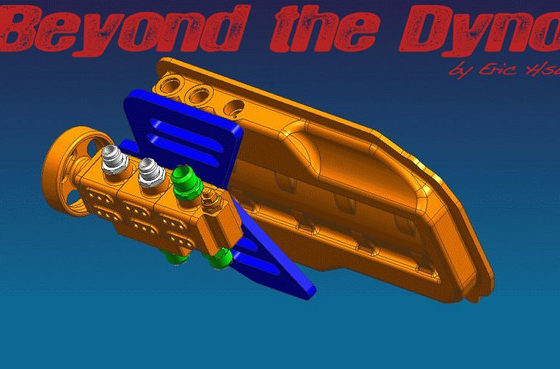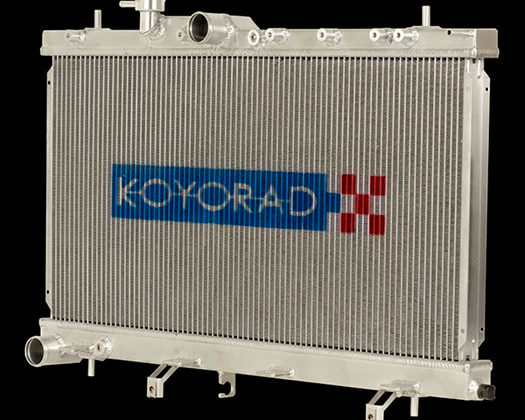,
 |
| The front struts have a large diameter shaft. The shaft extends entirely though the shock body and protrudes from the bottom of the damper. This is called thru-shaft technology. This increases the stiffness of the strut assembly due to more bearing overlap within the shock and eliminates the effect of shock fluid displacement caused by the shaft. This makes the damping more consistent through the range of travel and velocities and eliminates the wheel rate build up caused by gas reaction force. |
 |
| The rear damper uses the same technology as the front. Both dampers are equipped with Eibach ERS springs, the rear using a helper spring. The rear shocks use Hyperco's HLC's. HLCs are Hydraulic Load Couplers they eliminate side load and bind on the shock shaft caused by the spring kinking as it's compressed and moving through its stroke. The springs kinking and twist can cause several hundred lbs of side load on the shock causing bind and inaccurate damping. HLC's have been documented to reduce lap times as much as .7 seconds per minute. |
 |
| The Dynamic dampers are not two or three but 4-way adjustable, count the knobs. High and low speed compression and rebound are parametrically adjustable. I wish I had these. |
The suspension is very critical in any Time Attack car and the Sierra Sierra car is a mix of very sophisticated and straightforward technology. The most awesome part about the suspension is the Dynamic dampers. The Dynamic dampers have 4-way adjustment. Both the high and low speed compression and rebound damping are independently adjustable for incredible flexibility in platform control and bump absorption. The dampers use what is called through shaft construction. The shock shaft goes all the way through the damper body protruding from the bottom of the damper. This makes it so shaft fluid displacement isn’t an issue in the shock dynamic forces. In a conventional shock, there must be space inside the shock filled with compressible gas to make up for the displacement of the shock shaft as the suspension is stroked. Without that gas volume the shock would simply lock up because the fluid is incompressible. A large gas volume adds some hysteresis to the shocks damping and causes some lag between movement and application of damping force. With a through shaft the gas volume can be quite small and the damping remains constant through the stroke. There is no change in gas reaction force no matter where in the travel the shock is since the shaft is now not displacing and compressing the gas inside the damper body. The gas chamber in the damper only provides pressurization to prevent cavitation caused by high speed oil flow in the valves from causing variation in damping force and is very small in volume. The other advantage of a through shaft design is that there is a widely spaced lower bearing point on the bottom of the shock body to support the shaft with maximum overlap. This makes the damper have less bind and smoother action under side load and longer life.
 |
| The front knuckle/upright is a really cool piece, CNC machined from aluminum billet they relocate all of the suspension pick up points to correct roll center, camber curve and bump steer on the lowered car. Check out how the tie rod is held in double shear. Good engineering there. They also have larger wheel bearings and are considerably stiffer to eliminate any chance of brake caliper piston knockback. I hope Sierra Sierra produces these for sale. I want some for Project EVO! |
 |
| This blade controls the stiffness of the rear sway bar. When it's straight up and down, the bar is at maximum stiffness. When it's turned sideways, it flexes and softens the rear bar. The blade's rotation is controlled by a driver activated cable. |
 |
| The front bar is coupled conventionally via adjustable heim jointed end links. No mushy rubber here. |
 |
| This cable and linkage controls the rotation of the rear sway bar blade adjusters. |
 |
| The cable leads to this blue lever where the Emp can control the rear bar adjustment to control chassis balance as fuel loads and track conditions change. |
Eibach ERS springs are used all around with the spring rate being known only to the guys at Sierra Sierra. The sway bars are fabricated by Sierra Sierra, using tubular race type torsion bars with blade type adjusters for quick changes in roll stiffness to tune the chassis balance. The stock EVO suspension links are hard to beat as they are forged aluminum and Sierra Sierra modifies them to use spherical bearings instead of rubber bushings for geometry accuracy under forces generated by the sticky tires. The front spindles (uprights) are very interesting. They are machined out of solid aluminum billet and have revised pick up points to correct roll center, camber curve, scrub radius and bump steer. They also have larger wheel bearings to eliminate flex and brake piston knockback. The rear spindles are still factory and do have some bump steer issues at the current ride height, but team manager Richard Raeder plans on addressing the rear spindle next with something similar to the front.
 |
| The top mount of the strut is adjustable for camber, caster and steering axis. The lock plate assures that the adjustments will not slip. |
 |
| The rear mount adapts an eye type mount to the cars unibody. Solid spherical bearings ensure that every bit of travel is controlled by the damper. |
 |
| The cage on this car is very hard to photograph, it ties the entire car together from shock tower to shock tower to stiffen the chassis as well as to protect the driver. The Recaro seat has head protection and the center net helps keep the driver's upper body in place in the event of a crash. |
 |
| This rear cradle really stiffens up the back of the chassis. |
The rollcage can also be considered an important part of the suspension as a stiff chassis is critical for sensitivity to suspension tuning and for proper action of the suspension. A stiff chassis allows bumps to activate the suspension where oscillations can be controlled by the dampers instead of upsetting the chassis which when flexed acts like an undamped giant spring. Sierra Sierra built the custom welded in and well braced cage from tig welded DOM tubing. The interior uses a Recaro racing seat and Willians harnesses. The car weighs 2770 lbs without the driver but fully loaded with fluids.
 |
| Nagisa links adjust toe and camber in the rear of the car. Every single rubber bushing in the suspension has been replaced with spherical bearings. |
 |
| The Emp's office features a PI electronic dash display, Momo steering wheel, a dry carbon dash and a race type steering column. |
 |
| The center console has controls for mechanical and hydraulic brake force proportioning, map selection and other stuff for basic controls. |
 |
| A halon fire suppression system keeps things safe. |
 |
| A rear mounted dry cell battery saves weight and helps with weight distribution. |


Related






















